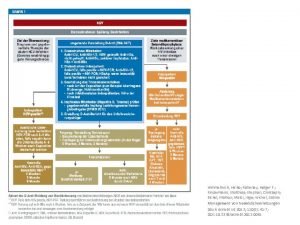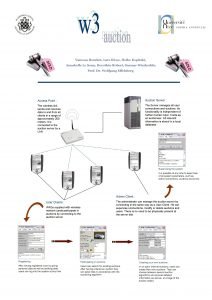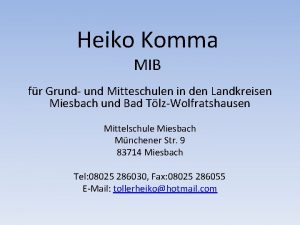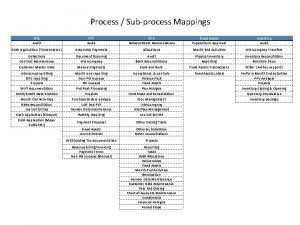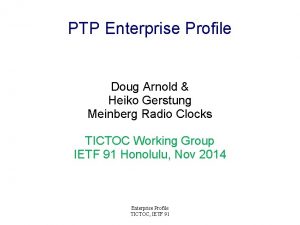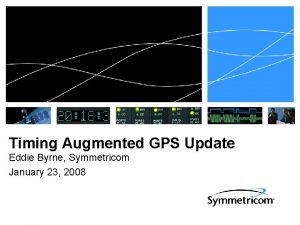Enterprise PTP profile Doug Arnold Symmetricom Heiko Gerstung












- Slides: 12

Enterprise PTP profile Doug Arnold, Symmetricom Heiko Gerstung, Meinberg November 8, 2012

Why an enterprise profile? • Many IT organizations deploying PTP – Looking for ~ ms precision – Measuring 1 way network delays – Measuring duration of multi-device operations – Determining the age of time stamped data – E. g. financial transactions – Other applications may follow • Current NTP not precise enough

Why the IETF? • IEEE 1588 committee only defined default profile – Telecom Profile: ITU – Power Profile: Protection Relay Society in IEEE – Audio Visual Bridges: IEEE 802. 1 – Test and Measurement: LXI Consortium • Enterprise Profile is for IT community – Layer 3 – LAN/WAN – IETF has the most expertise in this application domain

Requirements • Ordinary Clocks and Slaves can operate with no configuration with a predictable behavior based on the settings of the best master. – Auto discovery/Plug and play – Telecom Profile requires that all slaves are configured • Can scale up to networks with many subnets – Layer 3 – Power Profile is Layer 2 only and requires TCs • Robust in the presence of malfunctioning PTP devices • Accommodate complex servo-filters – To reduce queuing noise – Higher packet rates allowed

Hybrid PTP in the Field • The following slides describe the behavior of hybrid PTP operation • Independently developed by two equipment vendors • Also independently developed by a Network Architect at a financial company – Who rolled his own PTP solution • Something similar to this going to made into a standard by some organization – TICTOC is probably the best home for this

PTP settings: Required • Hybrid mode PTP – End to End Delay Measurement Mechanism – Multicast Sync and Announce Messages – Unicast Delay Request and Delay Response Messages – Minimize PTP traffic • Layer 3 IPv 4 and/or IPv 6 – If both are present, they are treated like separate networks • Slaves must be able to operate in a network with Alternate Masters – For redundancy, integrity checking, ensembling, …

PTP Management Messages • PTP Management Messages are optional • Any PTP Management Message which is relevant to only one PTP device must be sent in unicast to that device – To reduce multicast traffic generated by devices with management capability

Message Rates • Default rates – Announce Interval: 1 sec – Announce Time Out: 3 Announce Intervals – Sync rate 1/sec – Delay Request rate = 1/sec • Announce Interval, and Time Out must not change – To avoid master oscillating • Sync and Delay Request rates can be set by the user to different rates

Message TLVs • Announce Message should carry a TLV advertising hybrid or multicast/hybrid capability • Sync and Delay Request Messages should have a source address TLV – In case of 1 -step Transparent Clocks • TLV details TBD

PTP Options • Allowed – Alternate Master – Acceptable Master List – Boundary Clocks – Transparent Clocks • Forbidden – Alternative Time Scales – Master Clusters – Unicast Discovery/Negotiation – Peer to Peer Timing

Time Domains • We anticipate networks with pure multicast PTP and Enterprise Hybrid Profile PTP • Any Enterprise Hybrid Profile Master which is not capable of pure multicast operation must be in PTP Time Domain 4 -127 • Any Enterprise Hybrid Profile Master which is capable of mixed multicast and hybrid mode must be in PTP Time Domain 0 -127 • A smaller range of Domains should be reserved for the Enterprise Profile.

The question is… • Should TICTOC develop a hybrid mode Enterprise PTP Profile?




